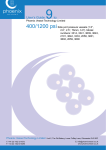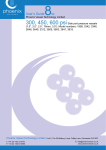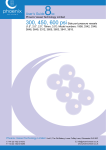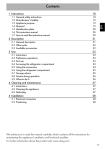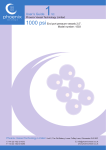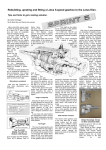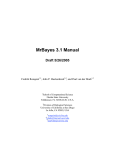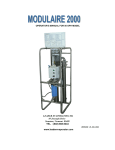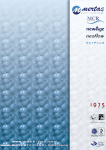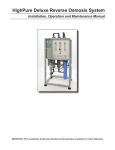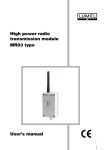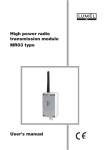Download User's Guide to: 1614 - 600 psi 3343 - 1000 psi 1381
Transcript
7 User’s Guide to: Phoenix Vessel Technology Limited End port pressure vessels Models: Phoenix Vessel Technology Limited T: +44 (0) 1452 311673 F: +44 (0) 1452 310295 1615 - 400 psi 1614 - 600 psi 3343 - 1000 psi 1381 - 1000 psi 1755 - 1200 psi Unit 2, The Old Bakery, Lower Tuffley Lane, Gloucester GL2 5DP E: [email protected] www.phoenixvessel.co.uk TABLE OF CONTENTS FORWARD SECTION 1 ‘Maintenance Guide’ 1.1 Removing End Cap from Vessel 1.2 Component Disassemby 1.3 Component Assembly 1.4 Loading Membranes 1.5 Closing Vessel 3 4 4 7 9 12 16 SECTION 2 ‘Installation’ 2.1 Handling 2.2 Vessel Support Position 2.3 Connections to Vessel 18 18 19 20 SECTION 3 ‘Operation’ 3.1 Corrosion 3.2 Operating Conditions 3.3 Safety Precautions 20 20 21 22 SECTION 4 ‘Appendix’ 4.1 Spare Parts List 4.2 Assembly Drawing 1615 4.3 Assembly Drawing 1614 4.4 Assembly Drawing 3343 4.5 Assembly Drawing 1381 4.6 Assembly Drawing 1755 23 23 24 25 26 27 28 2 of 27 USER GUIDE MAY 2012 FORWARD Phoenix Vessel Technology is a major manufacturer of Glass Reinforced Plastic Pressure Vessels which are used as housings for reverse osmosis membrane elements. It is one of a small number of companies with Code X accreditation of the American Society of Mechanical Engineers. Vessels are produced to cover a range of pressures upto 1200 psi and to house seven 40" or five 60" membrane elements. Each vessel has a documented history in terms of the manufacturing process and the materials used. Before despatch, each vessel is tested to 1.1 times working pressure to ensure structural integrity. This User`s Guide applies to the series of 8” End Ported pressure vessels which have a 1” female product tube connection. The following Assembly Drawings are applicable : (1) 1MNC 1615 (2) 1MNC 1614 (3) 1MNC 1381 (4) 1MNC 1755 - 8” 8” 8” 8” 400 psi Model 600 psi Model 1000 psi Model 1200 psi Model 3 of 27 USER GUIDE MAY 2012 SECTION ONE MAINTENANCE GUIDE 1.1 REMOVING END CAP FROM VESSEL 1.1.1 Ensure system is NOT pressurised before starting work. 1.1.2. Remove couplings connecting vessel ports to manifolds and move them clear of the vessel. Remove connections if fitted from the central product port. 1.1.3. Using an 8mm hexagonal T bar or Allen key remove the 3 caphead screws located in recesses in the cast retaining rings. 1.1.4 Remove the 3 segment retaining ring . Each segment has a slot at one end to enable it to be levered out. If removal is difficult then start at the point where the gap between two segments is greatest. It may 4 of 27 USER GUIDE MAY 2012 1.1.5 Grasp the two ports and remove the end cap with a gentle rocking motion. 1.1.7 If the End Cap cannot be removed as indicated then the use of an extractor will be necessary. The design consists of two tripods and 3 long cap head screws (M10x1.5) – these are screwed into the securing screw threads of the End Cap. Extraction load is applied via the large threaded bolt at the centre axis. This is illustrated below (although the exact design may differ slightly). The part number of this Extractor is 2986 5 of 27 USER GUIDE MAY 2012 1.2 COMPONENT DISASSEMBLY 1.2.1 With the end fitting extracted. Unscrew the backnut located on the product tube. Grasp the product tube and unscrew the product tube from the end cap approximately 2 turns until a gap of 5 to 10mm appears. 1.2.2 Push the product tube back into the end cap and at the same time pull out the black coloured collett at the other end of the product tube. The 5 to 10 mm gap should now appear on the other side of the end cap. 1.2.3 Using a small screwdriver prise open the collett by pushing the blade of the screwdriver into the gap. This should enable the product tube to release cleanly and preserve the threaded portion of it for re-use later. 6 of 27 USER GUIDE MAY 2012 1.2.4 Push the feed concentrate port forward so that the split retaining ring falls out. Remove the feed concentrate port from the end plate by pulling and twisting simultaneously. 7 of 27 USER GUIDE MAY 2012 1.3 COMPONENT ASSEMBLY 1.3.1 Thoroughly clean all parts and check for the following. (a) O-SEALS - cracked, worn or cut areas. (b) FEED CONCENTRATE PORT - bent or distorted. (c) BACKING PLATE - dented, anodising damaged or locating threads for cap head screws stripped. (d) SPLIT RETAINING RING - bent or distorted. (e) SEGMENTED RETAINING RING - bent or distorted. (f) CAP HEAD SCREWS - bent, corroded or threads damaged. (g) PRODUCT TUBE - threads damaged or sealing areas scratched. (h) END PLATE - cracks or scratches in sealing areas. (i) ADAPTOR - cracks or scratches in sealing areas. (j) ANTI-ROTATION COLLET - cracked or broken. (k) BACKNUT - cracked, broken or thread damaged. Components which show any of the above should be replaced. 1.3.2. CORROSION - Examine metal components for evidence of corrosion which might affect structural performance. Particularly pay attention to the backing plate and segmented retaining ring set. The backing plate may be cleaned using fine grade waterproof silicone carbide paper (600 grade or finer). Components which cannot be restored to the `as new’ condition should be replaced. NOTE : It is recommended that O-seals are replaced every time the end cap is rebuilt. NOTE : Damage to anodising may be temporarily repaired by sealing with epoxy paint. 8 of 27 USER GUIDE MAY 2012 1.3.3 Push the feed concentrate port through the off centre hole in the backing plate. Fit the split retaining ring and pull the feed concentrate port so that the ring is located in the counterbore of the backing plate. 1.3.4 Assemble the UPVC end plate with its O-seals. NOTE: Lubricate the O-Seals with Glycerine. Do not use grease as this may impair the perfor mance of the membrane elements. 9 of 27 USER GUIDE MAY 2012 1.3.5 Fit the endplate over the feed concentrate port and push it fully home until it contacts the backing plate. 1.3.6 Push the product tube into the endplate. Fit the anti-rotation collet onto the threaded part of the product tube followed by the 1.5” BSP backnut. Tighten the backnut until the product tube is gripped tightly. NOTE : Make sure that the chamfered edge of the endplate faces away from the backing plate and into the vessel. 10 of 27 USER GUIDE MAY 2012 1.4 LOADING MEMBRANES This Section is provided as a Guide only, reference should be made to the element manufacturers recommendations for loading. 1.4.1 UNLOADING MEMBRANE ELEMENTS (a) Ensure system is NOT pressurised before starting work. (b) Remove both end caps from vessel. (c) Remove thrust ring and adaptors from vessel. (d) Remove element from vessel following element manufacturers recommendations. 1.4.2 CHECKS BEFORE LOADING (a) Check the inside of the vessel for debris which may scratch the vessel. Remove any that is found by flushing with water or by using a clean cloth. Stubborn debris which adheres to the vessel may be removed by lightly polishing the area with waterproof silicone carbide paper. Use 400 Grade (fine) to start with and finish with 600 Grade (very fine). It will help to moisten the grit paper with water during use. Avoid continuously rubbing the same spot in the same direction. Afterwards remove any debris with water or by using a clean cloth. (b) Check that there are no sharp edges to the membrane element which could scratch the vessel. Contact the element manufacturer if these cannot be easily removed. (c) Check the element brine seal for wear and or cuts. Consult the element manufacturer for spares and advice. NOTE: Sharp debris may scratch vessel bore. This should be removed before unloading elements. NOTE: Fine grade Scotchbrite may be substituted for waterproof silicone carbide paper. 11 of 27 USER GUIDE MAY 2012 1.4.3 LOADING MEMBRANE ELEMENTS (a) Lubricate the inside of the vessel with glycerine. If this is not available then flood vessel with clean water. (b) Check with the element manufacturer concerning the position of the brine seal. Normally this is placed on the upstream end of the element with the recessed part of the seal pointing upstream. (c) Push the elements into the vessel from the upstream end. (d) As each element is loaded insert the interconnector. To ease insertion glycerine should be applied to the O-seals. (e) Care should be taken to ensure that the weight of the element is not taken on the interconnectors during loading. (f) The final element should be inserted the following distances in from the end of the vessel. Vessel Type 8” 1200 psi 8” 1000 psi 8” 600 psi 8” 400 psi End Port End Port End Port End Port Insertion Distance MIN MAX 12.0” (305 mm) 12.6” (321 mm) 11.0” (280 mm) 11.6” (296 mm) 10.0” (254 mm) 10.8” (274 mm) 9.6” (244 mm) 10.5” (267 mm) Insertion Distance (g) If the elements are pushed too far then continue pushing until the first element emerges from the other end of the vessel. Take care to support its weight as it emerges. 12 of 27 USER GUIDE MAY 2012 (h) Fit the Adaptors provided with the vessel end cap to the core tube of the elements at both ends. (I) If the element is of the spigotted type - i.e. has a core tube which is proud of the face of the element then Shims may be required to ensure that the element remains connected to the pressure vessel end fitting. These must be placed between the Adaptor and the Hub at the upstream end only - i.e. at the opposite end to the Thrust Ring. The Shim is a solid plastic washer: - OD 55mm; ID 33mm, by 5mm thick. A maximum of 8 at the upstream end of the vessel may be used. MAXIMUM OF 8 AT UPSTREAM END OF VESSEL ONLY (SHIM WIDTH 5MM) NOTE: Shims reduce wear on O-Seals by controlling the amount of free movement available to the element stack. They can be fitted on all element types. NOTE: Adaptors must be fitted to both ends of the stack of elements. Catastrophic failure of the product line can occur if adaptors are not fitted and pressure is applied. 13 of 27 USER GUIDE MAY 2012 The required number of shims may vary between any two vessels loaded with elements due to tolerance build up, each will require measuring to find the exact number. The ideal situation is to have a working float of 0.2” to 0.4” (5-10mm) at the upstream end of the vessel to allow for future thermal expansion and contraction. The best method of achieving this is to fit the maximum number of shims (8 at 0.2” thickness) and to keep subtracting shims one at a time until the retaining ring segments fit into the groove in the vessel. Finally subtract one more shim to ensure a safe float of 0.2”-0.4”. (J) Normally only one Thrust Ring is provided per vessel the correct location being at the downstream end of the vessel. The design of Adaptor and Thrust Ring ensures even loading over the face of the element. Prior to July 1993 there were two designs of thrust ring with different lengths. After July 1993 the longer length thrust ring was phased out and the corresponding adaptors shortened. The longer length of thrust ring was supplied for 8” vessels with the following elements : (1) Fluid Systems (2) Hydranautics (3) Dupont. NOTE : If adaptors or thrust rings are being replaced check that the new parts are the same length as the old. NOTE : Incorrect location of the thrust ring will damage the membrane elements. 14 of 27 USER GUIDE MAY 2012 1.5 CLOSING VESSEL 1.5.1 Check the inside of the vessel for debris which may scratch the vessel. Remove any that is found by flushing with water or by using a clean cloth. Stubborn debris which adheres to the vessel may be removed by lightly polishing the area with waterproof silicone carbide paper. Use 400 Grade (fine) to start with and finish with 600 Grade (very fine). It will help to moisten the grit paper with water during use. Avoid continiously rubbing the same spot in the same direction. Afterwards remove any debris with water or by using a clean cloth. 1.5.2 Lubricate the vessel inside surfaces with glycerine. 1.5.3 Lubricate the assembled end cap with glycerine, particularly the large 8” diameter O-seal. 1.5.4 Insert the end cap squarely into the vessel body sufficient to allow the segmented retain ing rings to be inserted fully into the groove in the end of the vessel. If the end fitting is dif ficult to push into the vessel then use the wooden shaft of a hammer to tap it into position. NOTE : Fine grade Scotchbrite may be substituted for waterproof silicone carbide paper. NOTE : Do not use excessive force to insert the end cap. A light tap is sufficient. 15 of 27 USER GUIDE MAY 2012 If the end cap cannot be easily inserted then the following checks should be carried out. (i) Lubricate vessel surfaces with more glycerine and try again. (ii) The elements may have been pushed too far, proceed as follows: Remove large 8” diameter seal from end cap. Remove adaptor from element. Remove small external O-seal from adaptor and insert into end cap. (iii) Without the O seals no effort should be required to insert the end cap, if there is still insufficient space to insert the retaining rings then the elements have been pushed too far during loading. Remove the last element by pushing it through the vessel taking care to support its weight as it emerges. Refer to Section 1..4 `Loading Membrane Elements’ for further information. 1.5.5. With the end fitting in place insert one of the three segmented retaining rings and fix with one of the three caphead screws. Do not tighten the caphead screw but leave loose as this will make for easier location of the remaining segmented rings. Put both of the remaining segmented rings into position before inserting the remaining cap head screws. Finally tighten all caphead screws handtight upto a maximum torque of 8Nm. 8NM TORQUE NOTE : Remember to refit all O-seals, thrust ring and insert adaptors into the central core tube of the first and last element in the stack. NOTE : A partially or badly assembled pressure vessel is dangerous. Carry out visual inspection on vessel to check compliance with these instructions. Check working area for any items left unassembled. 16 of 27 USER GUIDE MAY 2012 SECTION TWO INSTALLATION 2.1 HANDLING 2.1.1 Vessels may be stored horizontally in any warehouse where the temperatures are as follows: Maximum 45o C (113o F) Minimum 0o C ( 32o F) 2.1.2 DO NOT subject the vessel to sharp blows or impacts as this may damage the vessel wall. 2.1.3 DO NOT use the ports which project beyond the vessel as lifting or manoeuvring aids. 2.1.4 DO NOT scratch the vessel inside wall. 2.1.5 Slings wrapped around the vessel wall and suspended from the forks of a fork lift truck are safer and more stable than using forks alone. 2.1.6 Forks should always be padded before being brought into contact with any part of the vessel body. VESSEL DAMAGE This should be reported to the shipping company and Phoenix Vessel Technology Limited. 17 of 27 USER GUIDE MAY 2012 2.2 VESSEL SUPPORT POSITION The bending stresses generated in a long pressure vessel can be considerable and should not be ignored. Careful choice of support position can minimise bending stresses to an acceptably low level. Always follow instructions stated on the Assembly Drawing for each particular vessel design and length ordered. No. of 40’’ Elements No. of Supports 1 2 1.5 2 3 4 4.5 5 6 7 2 2 2 2 2 3 3 3 7.5 3 Distance rtween Supports (mm) Max Min 875 500 1400 1890 2910 3190 3375 Distance between Outer Supports (mm) Max. Min. 500 500 960 1970 2480 centre support 3560 4020 6170 2990 3800 5090 6220 5330 18 of 27 USER GUIDE MAY 2012 2.3 CONNECTIONS TO VESSEL 2.3.1 Mount vessels using support saddles provided on horizontal surface at the recommended support position and tighten straps to eliminate movement, do not tighten to more than drawing recommended torque. 2.3.2. Provide pressure relief device. This should be set to no more than 105% of design pressure. 2.3.3. Allow for an expansion of 0.5mm per metre length of vessel at design pressure. 2.3.4. Victaulic clamps used for connection to vessel should be assembled tightly with bolt pads of clamp halves metal to metal. NOTE : Excessive torque applied to the straps may damage the vessel wall and cause the strap nut to seize onto the threaded portion. SECTION THREE OPERATION 3.1 CORROSION - Operational pH level 3 - 10 - Cleaning only pH level 2 - 12 for no longer than 30 mins. Imediately clean down & purge. Whilst every effort has been taken to ensure that end fittings have adequate corrosion resistance it is the responsibility of the purchaser to assess that the materials offered are suitable for the specific corrosion environment. Alternate materials are available with enhanced corrosion resistance, contact Phoenix Vessel Technology Limited for advice. End fittings should be maintained dry and free from corrosion. Vessel leaks should be investigated and corrected. 19 of 27 USER GUIDE MAY 2012 3.2 OPERATING CONDITIONS DESIGN SPECIFICATION Internal Diameter: To fit any 8” nominal diameter element. Length: Up to 300” of membrane elements. Working Fluid: Water (brackish or seawater). Design Pressure: 400 psi (27.6 bar). 600 psi (41.4 bar). 1000 psi (69.0 bar). 1200 psi (82.8 bar). Test Pressure: 1.1 times design pressure for upto 15 minutes maximum. Design Temperature: 20 to 113o F (-7 to 45o C). Expansion: 0.5 to 0.6 mm per metre length of vessel at design pressure. Vacuum condition: Down to -14.5 psi (0 bar absolute). Support Position: 2 supports for 1 to 4.5 (40”) elements. 3 supports for 5 to 7.5 (40”) elements and any length supported outside of the recommended support range ( refer to `Vessel Support Position’ Section 2.2 this User`s Guide). NOTE : The standard materials of construction may not be compatible with cleaning and preserving fluids. Alternative materials are available on request. NOTE : The product tube must not be subjected to a pressure greater than 125 psi (8.6 bar) at 113 deg F (45 C). NOTE : The vessel should not be allowed to freeze solid. This will damage the vessel wall and make replacement necessary. 20 of 27 USER GUIDE MAY 2012 3.3 SAFETY PRECAUTIONS Fibreglass reinforced pressure vessels will provide years of safe service if properly installed and maintained. This section is for guidance only and should be used in conjunction with the recommendations in the previous sections. Attention is drawn to the `NOTES:` located at the bottom of the page which highlight potential problems areas and safety recommendations. 3.3.1 Provide pressure relief device. This should be set to no more than 105% of design pressure. 3.3.2 Before pressurisation visually check that the segmented retaining rings are in position and secured by the three cap head screws and that the backnut is fitted and is screwed up tightly. 3.3.3 DO NOT stand in line of end fitting while pressurisation takes place. 21 of 27 USER GUIDE MAY 2012 SECTION FOUR APPENDIX 4.1 SPARE PARTS LIST For part numbers and descriptions please refer to the relevant Technical Information Sheet. 22 of 27 USER GUIDE MAY 2012 23 of 27 USER GUIDE MAY 2012 24 of 27 USER GUIDE MAY 2012 25 of 27 USER GUIDE MAY 2012 26 of 27 USER GUIDE MAY 2012 27 of 27 USER GUIDE MAY 2012



























